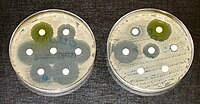
Photo from wikipedia
Advances in structural biology, genetics, bioinformatics, etc. resulted in the availability of an enormous pool of information enabling the analysis of the ancestry of pro- and eukaryotic genes and proteins.… Click to show full abstract
Advances in structural biology, genetics, bioinformatics, etc. resulted in the availability of an enormous pool of information enabling the analysis of the ancestry of pro- and eukaryotic genes and proteins. This review summarizes findings of structural and/or functional homologies of pro- and eukaryotic enzymes catalysing analogous biological reactions because of their highly conserved active centres so that non-antibiotics interacted with bacterial targets. Protease inhibitors such as staurosporine or camostat inhibited bacterial serine/threonine or serine/tyrosine protein kinases, serine/threonine phosphatases, and serine/threonine kinases, to which penicillin-binding-proteins are linked, so that these drugs synergized with β-lactams, reverted aminoglycoside-resistance and attenuated bacterial virulence. Calcium antagonists such as nitrendipine or verapamil blocked not only prokaryotic ion channels but interacted with negatively charged bacterial cell membranes thus disrupting membrane energetics and inducing membrane stress response resulting in inhibition of P-glycoprotein such as bacterial pumps thus improving anti-mycobacterial activities of rifampicin, tetracycline, fluoroquinolones, bedaquilin and imipenem-activity against Acinetobacter spp. Ciclosporine and tacrolimus attenuated bacterial virulence. ACE-inhibitors like captopril interacted with metallo-β-lactamases thus reverting carbapenem-resistance; prokaryotic carbonic anhydrases were inhibited as well resulting in growth impairment. In general, non-antibiotics exerted weak antibacterial activities on their own but synergized with antibiotics, and/or reverted resistance and/or attenuated virulence. Data summarized in this review support the theory that prokaryotic proteins represent targets for non-antibiotics because of a common evolutionary origin of bacterial- and mammalian targets resulting in highly conserved active centres of both, pro- and eukaryotic proteins with which the non-antibiotics interact and exert antibacterial actions.
Journal Title: Infection
Year Published: 2020
Link to full text (if available)
Share on Social Media: Sign Up to like & get
recommendations!